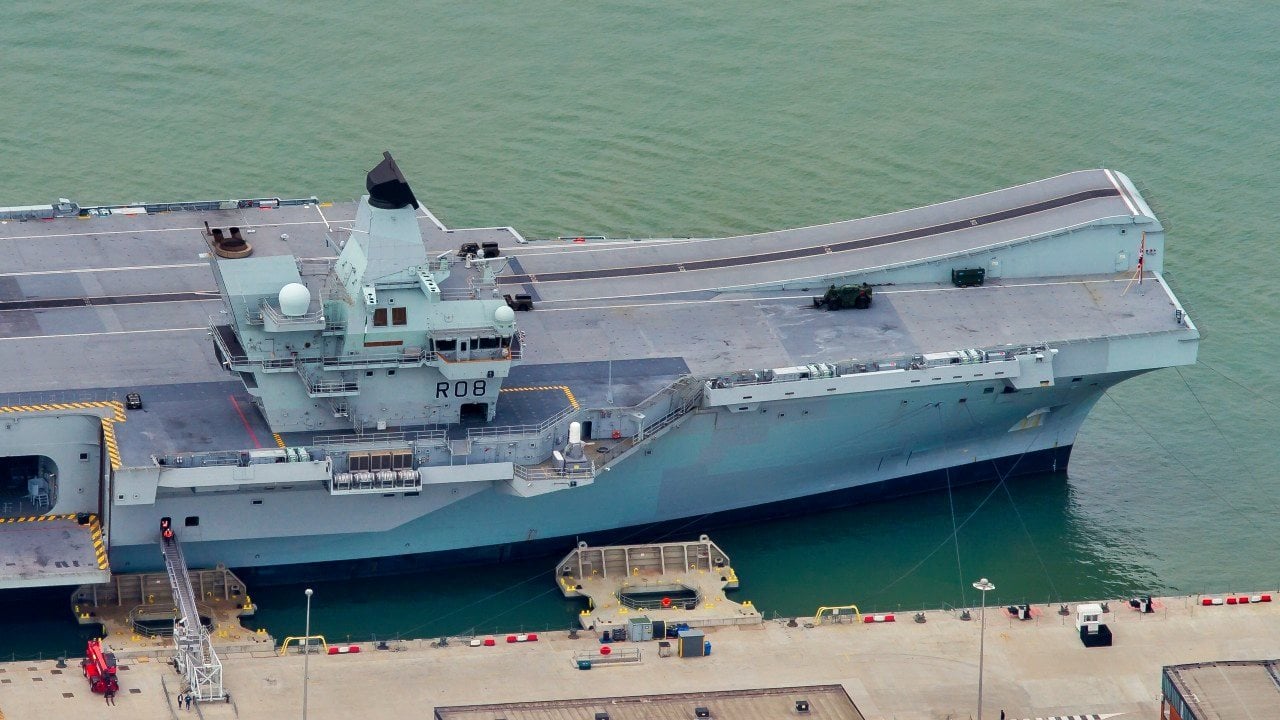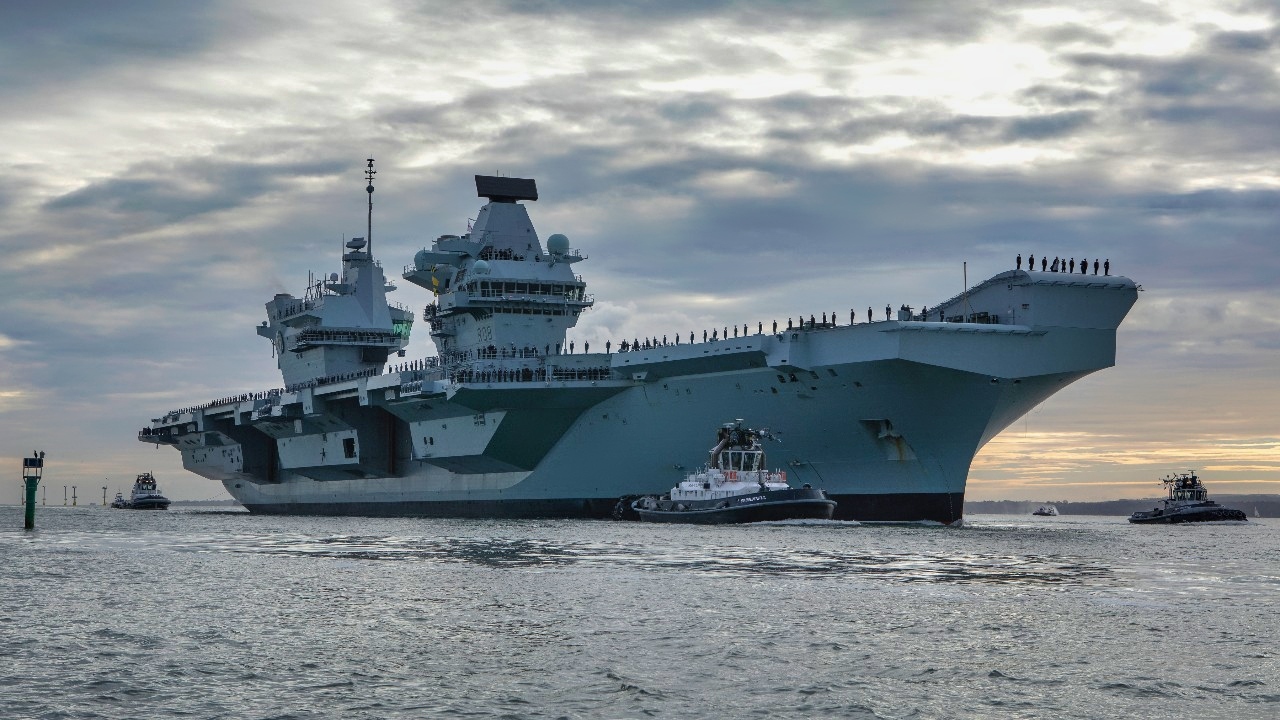The Royal Navy Can't Afford 2 Aircraft Carriers
Britain’s two aircraft carriers, HMS Queen Elizabeth and HMS Prince of Wales, are increasingly proving to be costly liabilities. At nearly $10 billion each, these carriers strain the cash-strapped Ministry of Defense (MoD), leading to tough choices like sacrificing other essential naval assets.
What You Need to Know: Britain’s two aircraft carriers, HMS Queen Elizabeth and HMS Prince of Wales, are increasingly proving to be costly liabilities. At nearly $10 billion each, these carriers strain the cash-strapped Ministry of Defense (MoD), leading to tough choices like sacrificing other essential naval assets.

-Financial pressures and operational risks in regions like the Indo-Pacific make maintaining these carriers challenging. Analysts suggest one carrier may need to be kept in reserve to cut costs, further highlighting Britain's difficulty in sustaining its naval power.
-This instability in military capability could make Britain an unreliable defense partner.
Britain Cannot Afford Two Aircraft Carriers
Britain has spent about $9.6 billion (£7.6 billion) per unit on its aircraft carrier force (there are now two carriers, the HMS Queen Elizabeth and the HMS Prince of Wales). These massive carriers are modern marvels. They’re also massive money pits for a British Ministry of Defense (MoD) that is cash-strapped and strategically adrift. The carriers are clearly aspirational. Indeed, when the Queen Elizabeth first came online in 2019, London was talking wistfully of—finally—returning East of Suez.
Alas, those pipedreams died when the sun finally set on the British Empire decades ago. These vestigial urges to sail the High Seas with expensive capital ships have already proven to be highly damaging to the British state, especially when her political leaders take the time to scratch those imperial phantom limbs.

Until recently, the British had difficulty in staffing these monstrosities. At the start of her lifespan, the British faced complicating factors with developing a robust airwing for the Queen Elizabeth. Every time these boats put to sea, British taxpayers can hear that giant sucking sound of another wasteful vanity project underway.
Oh, and to pay for these boats, the MoD has had to cannibalize key (and limited) assets that the British Navy actually needed (such as amphibious landers).
What’s Going On
Recent news suggests that both the HMS Queen Elizabeth and Prince of Wales have put to sea. This is great news for the carrier cult because the Queen Elizabeth was almost lost due to an accidental fire that erupted onboard the great ship. It was out of commission undergoing (costly) repairs that took months, leaving a massive strategic vulnerability for the entire British defense posture.
Anyway, the new Labor Party government in Britain has instituted steep cost savings measures that most assuredly will affect the future of the nation’s two aircraft carriers. As the defense publication, Naval-Technology.com outlines, “Despite the UK economy growing at a faster rate than any of its G7 partner countries, the new Labour [sic] government’s insistence of a [$28.5 billion] black hole in public finances and persistent negativity regarding the country’s economic outlook could see defence [sic] budgets face significant pressures.”
This is mealy-mouthed hedging. In fact, the MoD will be the first place that the new Labor regime slashes costs. And one of the biggest expenses, as noted above, are those aircraft carriers. The relative wastefulness and obsolescence of Britain’s carrier force has been highlighted by the British response to the Houthi Rebel threat in Yemen. Like the Americans, the British deployed naval assets to contend with the growing threat that the Iran-backed Yemen-based Houthi Rebels posed to international shipping. But the British kept their carriers out of the region.
Instead, the British Royal Navy deployed the Type 45 air defense destroyers to deal with the persistent Houthi threat. The Type 45 proudly claimed dozens of kills of Houthi drones and anti-ship missiles that were fired by the terrorist group at civilian ships. US Navy destroyers were also used repeatedly to engage Houthi targets. While the Americans did deploy carriers, notably the USS Dwight D. Eisenhower, those deployments were marred by the fact that increasingly accurate and powerful Houthi anti-ship ballistic missiles (ASBM) came within dangerously close range to the Ike.

Britain’s Strategic Posture is Even Messier Than America’s
Britain can ill-afford to have such dangers arise near their paltry two carriers (either of which, if lost would not only be a massive blow to Britain’s morale but would leave a gaping hole in England’s defense budget and its force readiness). Not to worry, though, the Royal Navy is deploying the HMS Prince of Wales to the Indo-Pacific area of operation. In turn, the Prince of Wales is pilfering the bulk of the Royal Navy’s carrier-based F-35B warplanes (these are coming from the airwing of the HMS Queen Elizabeth as well).
Just for the record, the Indo-Pacific region is far more contested by forces—notably China—that are greater in capabilities and reach than the Houthis. If the British are worried about possibly having their carriers damaged in combat with the Houthis, and if they are having trouble keeping both carriers operational simultaneously, then sending these boats into the Indo-Pacific to harangue the anti-access/area-denial (A2/AD) superpower that is China is truly foolish.
Naval-Technology.com writer Richard Thomas speculates that, like the two Albion-class amphibious assault ships (the HMS Albion and HMS Bulwark), the two British carriers could “take turns in mothballs.” This process of keeping one carrier in reserve while the other deploys “reduces operating costs for the Royal Navy and frees up the bulk of the 325-person crew back into the wider naval pool.”
An Unreliable Partner
But no one in London clearly sees the problem of paying to build two monstrosities and then being unable to maintain them or reliably deploy them in an increasingly contested global threat environment. For almost $18 billion to build these two ships, one must wonder if that money could have been better spent on cheaper, more numerous, next-generation platforms that might be more effective in the current era of A2/AD.
Clearly, Britain is going to be an unreliable military partner for the foreseeable future until it can get its economic house in order as well as figure out what it wants to do at a strategic level. That won’t happen anytime soon, given the political instability in Britain.
About the Author
Brandon J. Weichert, a National Interest national security analyst, is a former Congressional staffer and geopolitical analyst who is a contributor at The Washington Times, the Asia Times, and The-Pipeline. He is the author of Winning Space: How America Remains a Superpower, Biohacked: China’s Race to Control Life, and The Shadow War: Iran’s Quest for Supremacy. His next book, A Disaster of Our Own Making: How the West Lost Ukraine, is due October 22 from Encounter Books. Weichert can be followed via Twitter @WeTheBrandon.
Image Credit: Creative Commons and/or Shutterstock.
From the Vault
Russia Freaked Out: Why the U.S. Navy 'Unretired' the Iowa-Class Battleships
Battleship vs. Battlecruiser: Iowa-Class vs. Russia's Kirov-Class (Who Wins?)


